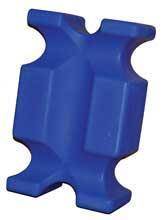

Also note the presence of both the first and fifth carpal bones (white arrowheads). 20-3 A, Lateromedial radiograph of a carpus, deliberately underexposed, to demonstrate the large superimposed medial and lateral protrusions at the caudal aspect of the distal radial physis (white arrow). Vestigial remnants of the ulna may occur in some horses and are visible radiographically when ossification of a fibrous remnant occurs ( Fig. 20-3, B), possibly with a notch in the articular surface at this location. 6 Until fusion of the distal radial and distal ulnar epiphyses occurs, a radiolucent line or rounded radiolucency may remain in the distal radial epiphysis ( Fig. The caudal aspect of the radius may be slightly irregular immediately proximal to the physis. 20-3, A), noted particularly on oblique projections. Incidental findings in the distal aspect of the radius include medial and lateral protrusions of the cortex at the distal radial physis in a mature horse ( Fig. The shape of the base of the fourth metacarpal bone is more normal. A fifth carpal bone is present (white arrow), but it is smaller and rounder than in the left forelimb. B, Dorsolateral-palmaromedial oblique radiograph of the right carpus of the same horse as in A. Also note the unusual shape of the base (head) of the fourth metacarpal bone. A fifth carpal bone is present (white arrow). 20-2 A, Dorsolateral-palmaromedial oblique radiograph of a left carpus. Fusion usually occurs, but radiographic separation may be identified during the first 6 months of age. 4 The accessory carpal bone may occasionally develop from more than one center of ossification. The first and fifth carpal bones are more likely to be present bilaterally, whereas radiolucent areas in the second carpal and metacarpal bones are more commonly unilateral. 20-1), are a normal feature of these articulations and should not be misinterpreted as a lytic lesion. 4 Lucent zones in the fourth carpal bone at the site of articulation of the fifth carpal bone, and in the second carpal bone and the proximal aspect of the second metacarpal bone at the site of articulation of the first carpal bone (see Fig. 3, 4 The fifth carpal bone occurs rarely, reported as an incidence of 1.4%. The first carpal bone occurs in approximately 30% of horses but varies widely in size and may articulate with one or both of the second carpal and metacarpal bones. These bones should not be confused with osteochondral fragments. The presence of the first and fifth carpal bones is variable, as is their shape and size and proximity to adjacent bones (Figs. Comparison with a normal set of radiographs and with bone specimens is helpful.

The complex anatomy of the carpus makes radiographic interpretation challenging.


The accessory carpal bone, situated on the palmar aspect of the carpus, articulates with the distal lateral aspect of the radius and the ulnar carpal bone. When the carpus is flexed, the radial carpal bone moves distally relative to the intermediate and ulnar carpal bones. The medial palmar intercarpal ligament joins the radial with the second and third carpal bones, and the lateral palmar intercarpal ligament joins the ulnar with the third and fourth carpal bones. 1 Within the middle carpal joint are two palmar ligaments, which attach the proximal and distal row of carpal bones. Within each row, the cuboidal carpal bones are connected by two interosseous ligaments, described as intercarpal ligaments, and two transverse dorsal ligaments. The antebrachiocarpal and middle carpal joints provide flexion and extension for the carpus, whereas the carpometacarpal joint is capable of only minimal motion. Vertically oriented joints between adjacent cuboidal carpal bones within each row are referred to as intercarpal joints. The carpometacarpal joint is the articulation between the distal row of carpal bones and the second, third, and fourth metacarpal bones. The middle carpal joint is the articulation formed between the proximal (radial, intermediate, and ulnar carpal bones) and distal (second, third, and fourth carpal bones) rows of carpal bones. 1 The antebrachiocarpal joint is formed by the distal aspect of the radius proximally and the proximal row of carpal bones (radial, intermediate, ulnar, and accessory carpal bones) distally. There are two rows of cuboidal bones interposed between the radius and metacarpus. The equine carpus is composed of three main articulations: the antebrachiocarpal joint the middle carpal joint, and the carpometacarpal joint.


 0 kommentar(er)
0 kommentar(er)
